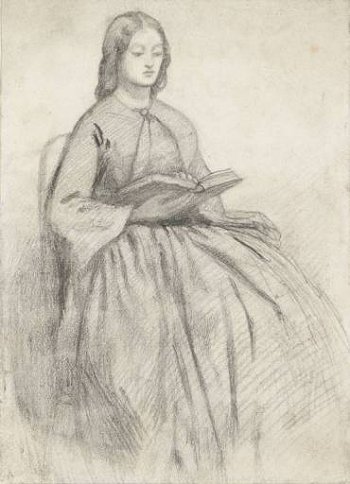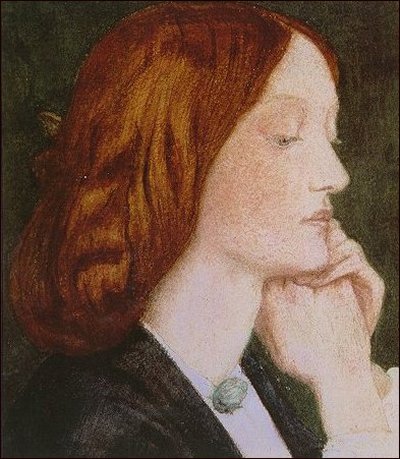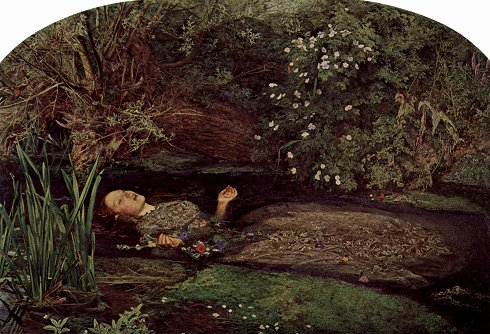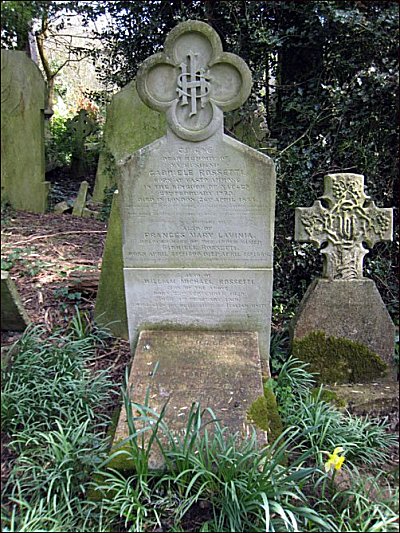Fleurs du Mal Magazine


Or see the index

Elizabeth (Lizzie) Siddal
(1829-1862)
Gone
To touch the glove upon her tender hand,
To watch the jewel sparkle in her ring,
Lifted my heart into a sudden song
As when the wild birds sing.
To touch her shadow on the sunny grass,
To break her pathway through the darkened wood,
Filled all my life with trembling and tears
And silence where I stood.
I watch the shadows gather round my heart,
I live to know that she is gone
Gone gone for ever, like the tender dove
That left the Ark alone.
Elizabeth (Lizzie) Siddal poems
fleursdumal.nl magazine
More in: Archive S-T, Lizzy Siddal, Siddal, Lizzy

Elizabeth (Lizzie) Siddal
(1829-1862)
Fragment of a Ballad
Many a mile over land and sea
Unsummoned my love returned to me;
I remember not the words he said
But only the trees moaning overhead.
And he came ready to take and bear
The cross I had carried for many a year,
But words came slowly one by one
From frozen lips shut still and dumb.
How sounded my words so still and slow
To the great strong heart that loved me so,
Who came to save me from pain and wrong
And to comfort me with his love so strong?
I felt the wind strike chill and cold
And vapours rise from the red-brown mould;
I felt the spell that held my breath
Bending me down to a living death.
Elizabeth (Lizzie) Siddal poems
fleursdumal.nl magazine
More in: Archive S-T, Lizzy Siddal, Siddal, Lizzy

Elizabeth (Lizzie) Siddal
(1829-1862)
Shepherd Turned Sailor
Now Christ ye save yon bonny shepherd
Sailing on the sea;
Ten thousand souls are sailing there
But they belong to Thee.
If he is lost then all is lost
And all is dead to me.
My love should have a grey head-stonee
And green moss at his feet
And clinging grass above his breast
Whereon his lambs could bleat,
And I should know the span of earth
Where some day I might sleep.
Elizabeth (Lizzie) Siddal poems
fleursdumal.nl magazine
More in: Archive S-T, Lizzy Siddal, Siddal, Lizzy

Special event at Highgate Cemetery London
for the 150th anniversary of Lizzie Siddal’s death
February 11th is the 150th anniversary of Lizzie’s death. To commemorate this, Highgate Cemetery (Lizzie’s final resting place) is having a Talk at the cemetery on that day by Lucinda Hawksley, author of Lizzie Siddal: Face of the Pre-Raphaelites.
From the Highgate Cemetery website: This is a unique and historic occasion as it is in commemoration of the 150th anniversary of Lizzie Siddal’s death: she died on February 11th 1862 and was buried at Highgate Cemetery six days later.
Lizzie Siddal was a nineteenth-century phenomenon: a working-class girl whose beauty made her the Pre-Raphaelite movement’s most celebrated, iconic face. Dante Rossetti, founder and leading light of the movement, painted and drew her obsessively a thousand times. She soon became a poet and artist in her own right.
However, as his lover and finally his wife, Lizzie’s relationship with Rossetti was blighted by his infidelities and neglect. In despair, Lizzie resorted to laudanum to numb her senses. In 1862 she took an overdose and left a suicide note.
Lucinda’s illustrated and vivid account of Lizzie’s meteoric but brief career and her tortured relationship breathes new life into the images of Lizzie frozen in time in galleries around the world.
The talk commences at 6.30 and will last around an hour. Booking: is in advance by email only at events@highgate-cemetery.org. Tickets: cost £10 each (£8 for students) including refreshments and nibbles. Space is limited so early booking is advised.

About Elizabeth Siddal
Elizabeth Siddal (July 25, 1829 – February 11, 1862)
While working in a millinery shop, Lizzie was discovered by the artist Walter Deverell who painted her as Viola in his depiction of Shakespeare’s Twelfth Night. Lizzie went on to model for other Pre-Raphaelite artists and is most commonly recognized as Ophelia in the painting by John Everett Millais, but was the charismatic Dante Gabriel Rossetti who not only drew and painted her obsessively, but encouraged Lizzie in her own artwork and poetry. Their relationship was intense and rocky, with an engagement that lasted on and off for a decade. Sadly, their marriage was short. The couple suffered a stillborn child and Lizzie was seriously addicted to Laudanum. She died in 1862 due to an overdose. The rest of Lizzie’s tale is eerily famous for its gothic Victorian morbidity: Rossetti, in his grief, buried his only manuscript of his poems with Lizzie. The poems, nestled in her coffin amidst her famous red hair, haunted him. Seven years later, he had her coffin exhumed in order to retrieve the poems for publication. The story was spread that Lizzie was still in beautiful, pristine condition and that her flaming hair had continued to grow after death, filling the coffin. This, of course, is a biological impossibility. Cellular growth does not occur after death, but the tale has added to Lizzie’s legend and continues to capture the interest of Pre-Raphaelite and Lizzie Siddal enthusiasts.

The story of Lizzie’s life is punctuated with dramatic episodes such as falling ill as a result of modeling as Ophelia,, the tales of Rossetti’s dalliances, and her grief at the loss of their stillborn daughter. Our modern society is much more aware and educated than the Victorians regarding mental health issues. Unfortunately for Elizabeth Siddal, she lived in a time where addiction was a taboo subject and little was known about post-partum depression. Lizzie lived within a cycle of illness, addiction and grief with no resources available to her. And although she did have a creative outlet while most women were denied modes of self expression, Lizzie was never able to move beyond the addiction that claimed her life.
Source: website LizzieSiddal.com

fleursdumal.nl magazine
More in: Galerie des Morts, Lizzy Siddal, Siddal, Lizzy
Thank you for reading Fleurs du Mal - magazine for art & literature